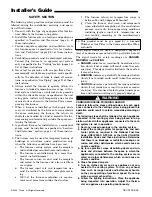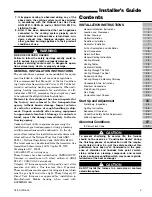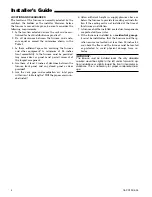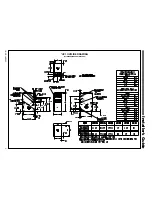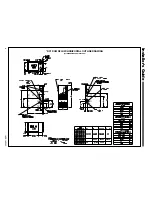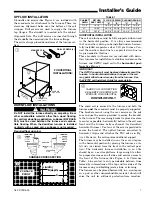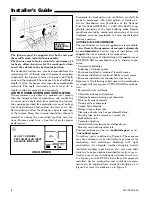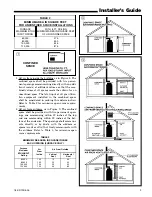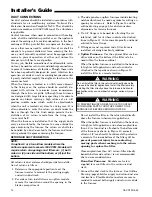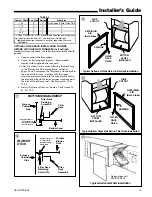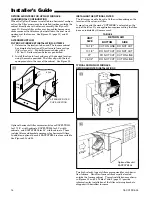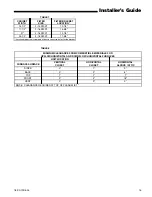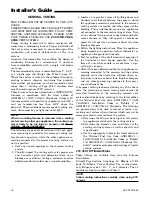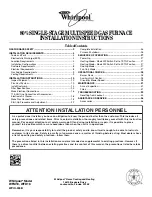
18-CD19D5-25
3
Installer’s Guide
INSTALLATION INSTRUCTIONS
General Installation Instructions
3
Location and Clearances
4
Outline Drawings
5
Upflow Installation
7
Downflow Installation
7
Horizontal Installation
7
Air For Combustion and Ventilation
8
Duct Connections
10
Return Air Filters
11
General Venting Instructions
16
Venting Material
16
Venting Tables
18
Horizontal Venting
21
Venting Through The Wall
21
Venting Through The Roof
25
Downward Venting
25
Venting Through a Masonry Chimney
26
Condensate Drain Instructions
27
Electrical Connections
29
Field Wiring Diagrams
29
Gas Piping
32
Combustion Input Checks
33
Start Up and Adjustment
35
Preliminary Inspections
35
Lighting Instructions
36
Sequence Of Operation
36
Control And Safety Switch Adjustments
36
Airflow Adjustment
37
Abnormal Conditions
37
IFC Error Flash Code
39
Contents
▲
WARNING
!
FIRE OR EXPLOSION HAZARD
Failure to follow the safety warnings exactly could re-
sult in serious injury, death or property damage.
Improper servicing could result in dangerous opera-
tion, serious injury, death, or property damage.
GENERAL INSTALLATION INSTRUCTIONS
The manufacturer assumes no responsibility for equip-
ment installed in violation of any code or regulation.
It is recommended that Manual J of the Air Condition-
ing Contractors Association (ACCA) or A.R.I. 230 be fol-
lowed in estimating heating requirements. When esti-
mating heating requirements for installation at alti-
tudes above 2000 ft., remember the gas input may need
to be reduced (See High Altitude Installation).
Material in this shipment has been inspected at
the factory and released to the transportation
agency without known damage. Inspect exterior
of carton for evidence of rough handling in ship-
ment. Unpack carefully after moving equipment
to approximate location. If damage to contents is
found, report the damage immediately to the de-
livering agency.
Codes and local utility requirements governing the
installation of gas fired equipment, wiring, plumbing,
and flue connections must be adhered to. In the ab-
sence of local codes, the installation must conform with
latest edition of the National Fuel Gas Code ANSI
Z223.1 • National Installation Code, CAN/CGA B149.1.
The latest code may be obtained from the American Gas
Association Laboratories, 400 N. Capitol St. NW,
Washington D.C. 20001.
1-800-699-9277 or www.aga.org
These furnaces have been classified as CATEGORY IV
furnaces in accordance with latest edition of ANSI
Z21.47 • CAN/ CGA 2.3 standards.
Category IV furnaces operate with positive vent static
pressure and with a flue loss less than 17 percent.
These conditions require special venting systems, which
must be gas tight and water tight. These Category IV
Direct Vent furnaces are approved for installation in
Manufactured/ Mobile housing when used with
BAYMFGH100A.
▲
CAUTION
!
T
o prevent shortening its service life, the furnace
should not be used as a “Construction Heater” during
the finishing phases of construction until the require-
ments listed in item 9, a-g of the safety section of this
publication have been met. Condensate in the pres-
ence of chlorides and fluorides from paint, varnish,
stains, adhesives, cleaning compounds, and cement
create a corrosive condition which may cause rapid de-
terioration of the heat exchanger.
▲
CAUTION
!
Do NOT install the furnace in a corrosive or contami-
nated atmosphere.
7. If improper venting is observed during any of the
above tests, the venting system must be corrected
in accordance with the National Fuel Gas Code,
ANSI Z221.1/ NFPA 54 and/ or CAN/ CGA B149 In-
stallation Codes.
8. After it has been determined that each appliance
connected to the venting system properly vents
where tested as outlined above, return doors, win-
dows, exhaust fans, fireplace dampers and any
other gas-fired burning appliance to their previous
conditions of use.


